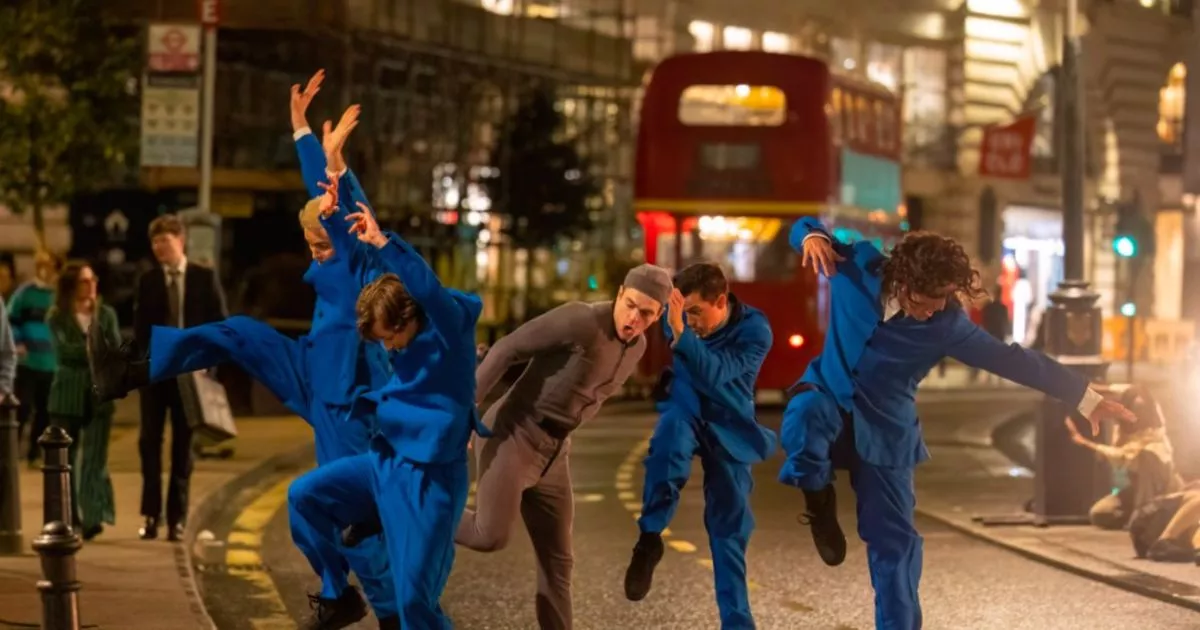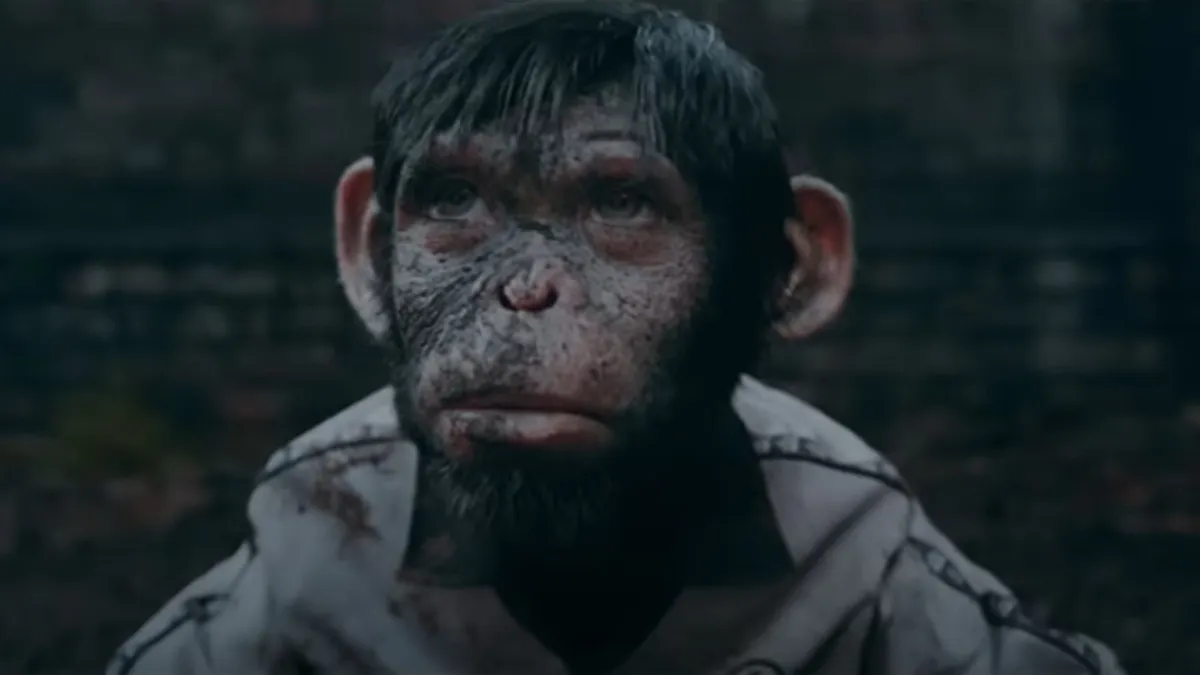Better Man Review (2024): A Battle for Fame, Forgiveness, and Acceptance
- Tavia Millward
- Mar 3
- 4 min read
Updated: Mar 25
"Dance for me, monkey, dance." A cruel demand, a metaphor, and the essence of Better Man(2024) - a surreal biopic where fame isn't just a stage but a battleground. Over two hours Robbie Williams wrestles with addiction, self-doubt, and acceptance - culminating in a mind-blowing CGI fight that feels more like a Planet of the Apes than a pop star redemption.

Robbie Williams (Jonno Davies) is not just another troubled musician in a UK biopic—he’s a performer trapped in a relentless act, always on stage, even when no one's watching. The film introduces us to young Robbie, bonding with his father, Peter (Steve Pemberton), over Frank Sinatra songs. Their shared love of performance is the foundation of Robbie’s dreams, but when his father abruptly leaves, it plants the first seed of abandonment that will haunt him for years.
Teenage Robbie, craving validation, flunks school and throws himself into the spotlight, auditioning for a boy band. He’s brash, reckless, and desperate to prove himself. His talent gets him through the door, but even as he rises to fame, he remains the outsider—never fully accepted by his bandmates, never truly belonging. Fame gives him everything, yet nothing he needs.

As the years pass, Robbie leans into the chaos, drinking excessively and spiralling into drug addiction. His departure from the band isn't just a career shift—it’s another rejection, reinforcing his deepest fears: he isn’t good enough, he isn’t wanted, and no one sees his true potential.
The voices in his head—the ones we all have—grow louder, feeding his insecurities. And just as he reaches rock bottom, his estranged father suddenly returns, eager to manage his now-famous son. But is it love, or is it business? Peter ignores the addiction, the crumbling relationships, and the wreckage of his son’s life. As long as Robbie keeps performing and dancing like the monkey everyone expects him to be, the show must continue.
It all leads to Wembley Stadium, the biggest concert of his life, and his final reckoning. The film takes a surreal turn as Robbie, during his performance, is confronted by physical manifestations of his self-doubt, addiction, and childhood trauma. In a jaw-dropping CGI sequence, he fights distorted versions of himself—each one a different era, a different failure, a different voice whispering that he’ll never be enough.

It’s one of the most unexpected moments in any musical biopic—a sequence that blends Black Swan levels of psychological horror with Planet of the Apes intensity. But this isn’t just about spectacle; it’s the emotional climax of his story. For the first time, Robbie doesn’t try to drown out his demons with alcohol or applause—he faces them head-on, tearing them apart one by one. And when the dust settles, he’s left with the one part of himself he’s avoided for so long: his inner child.
Robbie enters rehab, reconciles with his past relationships, and makes amends—not just to others, but to himself. His journey isn’t wrapped up in a neat bow, but it doesn’t have to be. The final scene is a quiet, full-circle moment: Robbie at his grandmother’s grave, watching telly, just as they used to. No audience, stage, or performance—just Robbie, finally at peace.
In the end, Better Man is about more than the highs and lows of fame. It’s about the long road to self-acceptance, the weight of childhood wounds, and the power of forgiveness—not just of others, but of oneself. Robbie doesn’t just return to music; he reclaims it. And when he finally sings cabaret with his father in front of a crowd, it’s no longer for validation—it’s a choice, a moment of closure, and maybe, just maybe, a step toward something real.

Behind the Scenes of Better Man: A CGI Masterclass in Musical Storytelling
Blending CGI with a musical biopic is an ambitious feat, but Better Man pushes the boundaries of digital storytelling, transforming an intimate tale of fame and self-destruction into a visually striking spectacle. Unlike traditional CGI-heavy blockbusters, where effects serve as external world-building, the visual effects in Better Man are entirely psychological, illustrating Robbie Williams’ internal struggles through surreal, hyper-stylized imagery. From seamless motion capture to integrating digital doubles in emotionally charged performances, the production team faced the unique challenge of merging the expressive physicality of a musical with the weightlessness of CGI—a task rarely attempted in this genre.
One of the film’s most technically demanding sequences—the climactic battle between Robbie and his fragmented selves—required months of pre-visualization, choreography, and cutting-edge performance capture. Each version of Robbie, from the young boy dreaming of stardom to the jaded rockstar drowning in excess, was played by lead actor Jonno Davies, digitally manipulated to interact with his other personas in real time. Unlike action films that rely on stunt doubles, Better Man demanded that every movement be emotionally grounded, meaning Davies had to fight versions of himself while maintaining the authenticity of a stage performer. The challenge was to ensure that the spectacle did not overshadow the raw vulnerability of the scene—an achievement that speaks to both the film’s technological advancements and Davies' acting prowess.
To bring musicality to the CGI-heavy sequences, the filmmakers developed a groundbreaking motion-sync system that mapped body movement to the film’s soundtrack, ensuring a natural rhythm in every digitally enhanced scene. This was particularly crucial for the concert sequences, where Robbie’s performances had to blend live-action choreography with digital augmentation. Every camera move, lighting cue, and digital enhancement was meticulously planned to maintain the feeling of a live concert while allowing for seamless transitions into heightened, dreamlike moments. By engineering a post-production pipeline that prioritized organic movement over artificial perfection, Better Man sets a new standard for integrating digital effects into musical storytelling.
Perhaps the greatest triumph of Better Man is how it uses CGI not as a gimmick but as an emotional tool—elevating the film’s themes of fame, identity, and redemption. The film doesn’t just show Robbie battling his demons; it immerses the audience in the disorienting, hyper-real world of his fractured psyche. This fusion of technology and emotion transforms the biopic genre, proving that visual effects can be as powerful in conveying human vulnerability as they are in crafting fantasy landscapes. For actors, filmmakers, and cinephiles alike, Better Man is a masterclass in how innovation can serve storytelling, redefining what’s possible when artistry and technology collide.












Comments